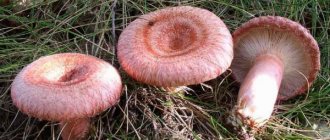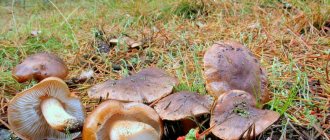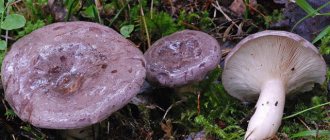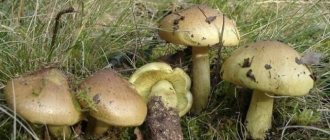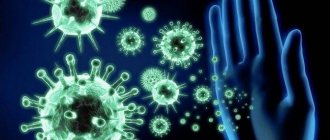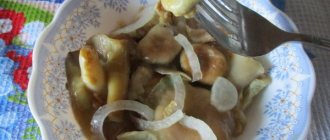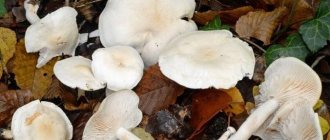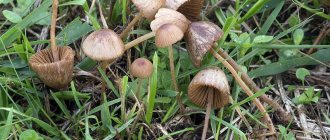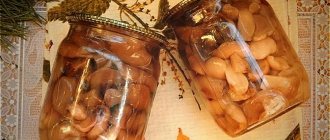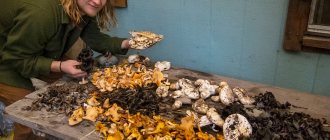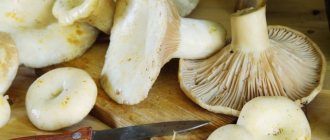Even in the leanest years, it is not so difficult to find mushrooms with waves on the cap in the forest. Most often it is pink and white wave, although other colors are also found. Because of their hot milky juice, representatives of this variety are considered conditionally edible in many European countries, while in Russia they are happily consumed in salted form, after preliminary preparation.
To get a tasty and healthy product, you need to know where they grow, when they are collected, and how to distinguish them from pink ones and from false doubles.
Are there white waves?
The closest relatives of the trumpet are russula. In appearance, they resemble saffron milk caps, only their color is different, and the edges are curled and velvety. There are several subspecies that differ in color, but their taste is almost the same.
In addition to the white variety, there are:
- pink, or Volzhanka;
- yellow, or wave;
- gray, or milky gray.
The most popular are pink and white waves. The former are distributed throughout Russia. White mushroom, or white mushroom, grows in large quantities in Siberia.
Description
The white mushroom (also known as “white volnushka” or Lactarius pubescens) is a conditionally edible lamellar mushroom belonging to the Russula family, the genus Mlechniki.
- The cap is at first convex, white with a pinkish tint, with a fluffy edge strongly tucked inward; with age it becomes flat, smoother, depressed closer to the center. The average diameter is 3-7 cm.
- the pulp, as the name suggests, is white, but pinkish under the skin. The milky juice is white, does not change color in air, and is bitter.
- the stem of the mushroom has a cylindrical shape, height - 3-6 cm, diameter 0.7-2 cm. As the mushroom grows, it gradually becomes hollow. The surface is white or light pink.
- the plates are frequent, thin, adherent or slightly running down the stem, light fawn or pinkish, and do not change their color over time.
What does a whitefish look like?
The white mushroom is a conditionally edible species. Whitefish is a milkweed that secretes juice that is bitter and pungent in taste, which does not change when exposed to air. In general, the pulp is not very hard, white, slightly pinkish under the skin, not crumbling, like russula. Volushki are salted according to the general rules for the species: the beneficial and taste qualities are in no way inferior in their characteristics to the pink, yellow and gray varieties.
According to the photo and description, the white wavefish has a less attractive appearance than the pink one - its leg is shorter, and its color is light fawn. Because of this, it seems a little dirty. There is a light fluff on the edge of the cap. This surface is a distinctive feature of all types of waves. Mushroom pickers note that whiteweed emits a slight smell of geranium and grows next to birch trees, forming mycorrhiza with them.
Important! The older the mushroom, the smoother the surface of its cap, and the color acquires yellowish tints. Such specimens are not suitable for food.
Description of the cap
As you can see in the photo, the white mushroom has a funnel-shaped cap, its diameter reaches 4 cm in young specimens, and up to 12 cm in old specimens. At first it is convex, has dense pubescence, especially along the edges, which are strongly curved inward.
Later, the cap increases in size, a depression appears in its center, and the edges gradually unfold. The skin does not have a pattern in the form of rings, like other subspecies. In the center the shade is slightly darker than at the edges. The pulp is white, brittle, with an acrid milky juice and a pungent taste; its smell is light and pleasant.
The cap plates are frequent, narrow, adherent, at first they are white, but in adult fruiting bodies they are yellowish. Spore powder is ocher in color.
When it rains, the white wave becomes slimy and not very beautiful.
Description of the leg
Judging by the photo and description, the white mushroom in adulthood has a stalk about 4 cm long and 2 cm in diameter. Its shape is cylindrical, the surface may be slightly pubescent, but most often with a smooth skin. Young fruiting bodies have a dense structure. Later, at a more mature age, their leg becomes hollow and very brittle. Its shades change over time from white and pinkish to a yellowish-dirty color.
From this part of the mushroom, as from the cap, white, acrid, milky juice is also abundantly released, especially when scrapped.
The shape of the stem depends on the location of the fruiting bodies. In open spaces it is very short - about 3 cm. In white trumpets that grow in tall grass, it is long - 8 - 10 cm. Specimens with short legs are most often narrowed towards the base.
Cooking methods
Most often, edible milkweeds are salted or pickled. They should absolutely not be consumed raw, and even before heat treatment they must be soaked in water. You can make healthy canned food from them using regular salt and citric acid.
Volnushki pickles
Pepper, as a rule, is not used because the pungent taste of the fruit compensates for the spice properties. In addition, there are ways to prepare Volzhanka in simpler ways while maintaining beneficial properties.
Cooking
For a kilogram of fresh mushrooms you will need a tablespoon of salt and a sufficient amount of water. Before cooking milkfish, they must be thoroughly cleaned of debris, lint, scales, washed and the stem cut off (for small specimens, you can simply remove the tip of the stem).
Cooking trumpets
Cook for 15-20 minutes, then change the water and boil a little more. After these procedures, you can prepare dishes according to different recipes or start pickling.
Frying
You can also fry such mushrooms. For 1 kg of milkweed you need to take two onions and one and a half tablespoons of salt, as well as spices to taste.
Fried volnushki
The washed and peeled fruit bodies are boiled for half an hour, the chopped onions are fried in a frying pan. Then add the prepared volushki and fry everything together for about 10 minutes.
Is the white trumpet edible or not?
Opinions differ regarding the edibility of the white trumpet. Some mushroom pickers are happy to collect them, others consider them inedible and leave them in the forest. In the guides and reference books used in Western Europe, white mushrooms are classified as poisonous mushrooms, prohibited for collection and consumption as they lead to gastrointestinal disorders. In Russia, white fiber is harvested and, after appropriate processing, used for food.
Raw mushrooms are bitter due to the milky juice. To get rid of bitterness, pink volnushki and whitefish are soaked, after which they are salted. These are conditionally edible mushrooms that require additional heat treatment, so they are classified in the second category.
According to a 10-point assessment of nutritional, taste and aesthetic qualities, white trumpets received 6.2 points and were approved by GOST for harvesting in the USSR.
How to process whites before cooking
White mushrooms are not suitable for making soups or frying, but they are excellent for pickling. Soaking helps get rid of the bitterness of the milky juice. For this purpose, whitefish are immersed in cold salt water for several hours, after having previously cleared them of leaves, soil and debris. After this, the water is drained, then the raw materials are placed in hot salted water and boiled for half an hour. The first water should be drained and boiled for 15 minutes in new water. After such heat treatment, you can begin salting or pickling white trumpets strictly according to the recipe.
Important! If the mushrooms are not cooked enough, then even 6 - 7 months after cooking, bitterness will be felt in the pickled or salted mushrooms.
Use in cooking
Crispy and juicy whitefish will decorate and diversify the winter menu of any family. Volushki are salted in different ways: cold and hot. Young specimens, with the edges of the cap folded inside the cap, are best suited for this.
Method number 1. Cold salting: the mushrooms must first be thoroughly soaked for 2-3 days with regular changes of water. Then start preparing for the winter.
Method number 2. Hot salting: it is necessary to boil the volushki longer so that all the bitterness is removed from them. Therefore, people also call them “decoctions.” These are one of the most pungent fruiting bodies (like milk mushrooms), but after proper processing they become tasty, especially salted ones.
Where do whites grow?
In Russia, whitefish can be found in the Central and North-Western regions, Siberia, the Urals and the North Caucasus. Volnushki live only in symbiosis with birch, forming mycorrhiza with it. The mushroom helps the tree absorb salts and minerals, and itself absorbs organic substances synthesized by the birch. Thanks to this union, the white trumpet grows mainly in birch groves, but it can also be found in mixed forests. It is located not far from saffron milk caps and boletuses. The white wavefish prefers sunny places, so most often it can be found on the edges or at the entrance to the forest.
Whitefish love to grow in families in damp, swampy areas, so in rainy years their maximum yield is observed, provided the weather is warm. The age of the birch trees near which the mushrooms are located does not matter. They can also be found in very young birch trees.
Spreading
Volushka mushrooms mainly grow in mixed or deciduous young forests. They can also be found near forest and country roads, in meadows, clearings and forest edges. They grow both in groups and individually. The habitat regions are dominated by Siberia, the Urals, the North Caucasus, as well as the center and north-west of the country. One of the key conditions for the growth of the fungus is the presence of birch trees nearby.
Belyanka usually bears fruit from the beginning of August to the end of September, less often - until mid-October.
When are whites collected?
The time for collecting white trumpets begins in August and lasts until the end of September or mid-October, depending on when frosts begin. In the first half of summer it is very difficult to find whitefish.
Most often, the rich harvest of white trumpets is divided into two stages. The first harvest occurs in August, the second in September.
During the “silent hunt” you should pay close attention to what goes into the basket. You can get advice from experienced mushroom pickers or look at a photo in a reference book of what a white mushroom looks like after reading about its distinctive features. And, although the whites do not have poisonous counterparts, it is worth discarding the mushroom if its origin raises even the slightest doubt.
Whitefish dishes
Belyanka in batter
To prepare whites in batter, mushrooms salted either hot or cold are suitable. The volnushki are thoroughly washed and the water is allowed to drain completely. Further whites can be:
- bread alternately in flour, egg and again in flour;
- dip in egg and roll in breadcrumbs;
- prick with a fork, dip into a batter of one egg, 4 tablespoons of flour and 100 ml of cold water.
The whites prepared in one of the listed ways are fried in vegetable oil. Served with potatoes.
Salad with salted white mushrooms
Half a finely chopped onion is fried in vegetable oil until golden brown, cooled and mixed with three potatoes, boiled in their skins and cut into large cubes. White trumpets are washed, cut into strips and added to the salad. Next, add 4 finely chopped boiled eggs and season the salad with mayonnaise. Sprinkle green onions on top.
Tomatoes stuffed with pickled whites
Cut off the top of round ripe tomatoes and carefully remove the core. Place on a paper towel with the hole facing down to drain excess moisture. Prepare the filling: the pickled white trumpets are washed, allowed to drain and cut into cubes. Then add sour cream, finely chopped green onions and fill the prepared tomatoes with this mixture. The top of the dish is sprinkled with herbs.
How to distinguish white waves from false ones
Mushrooms that are similar to white mushrooms and white mushrooms are their counterparts and belong to the laticifers, whose caps are pinkish and may have reddish rings. There is no edge. The fruiting body of the whitefish is small, its juiciness is low.
There are several edible milkweed twins.
Ordinary
The hat of the common representative is shiny. At first it is convex and gray, later it becomes flat, brown, purple or yellow. The edges of the mushroom are rounded, the stem is cylindrical. The milky juice is greenish.
Faded milkman
The cap of this double is lilac, gray or white, has a bulge, is depressed in the center and is somewhat darker than at the edges. The leg is light, slightly curved.
Brownish
This variety has a cap that is velvety to the touch, brown or chocolate-colored. Its shape gradually changes from convex to concave. When broken, the flesh turns pink and has a light fruity aroma.
Brown
The cap of this species is convex, chestnut or brown, and can be almost black. Later, a concavity appears on it. The leg is the same color as the cap. The milky juice is not caustic.
Hygrophoroid
The hat of this double is dry, brown with a brown tint. The hygrophoroid mushroom is distinguished by the fragility of its white flesh.
Burning milky
This variety has a moist cap covered with mucus. Its flesh is gray, dense, has a mushroom aroma, and has a burning taste.
Spiky
The color of the cap changes from pink to brown, there are red scales. The flesh is white, yellow or green. There is no smell, the taste is characterized as pungent. Edible white mushrooms and false white mushrooms differ in size and external characteristics. False mushrooms are no larger than a chicken egg, and they have a depression in the center of the cap.
Sticky
The cap of this representative is gray-green with dark spots. Its leg is sticky, lighter than the cap. The pulp is odorless, white, green when broken.
Hepatic
The mushroom has a smooth, funnel-shaped cap of brown color. Its flesh is pungent and light brown. The milky sap turns yellow when exposed to air.
In order not to make a mistake in your choice when picking mushrooms, you should thoroughly study the photos and descriptions of white and false mushrooms, compare them and remember the main differences.
What is the difference between pink flukes and whites?
In order not to confuse white and pink waves, it is worth remembering that they have several differences:
- different colors of hats - white and pink;
- the whitefish does not have concentric circles;
- The white variety grows in damp places, the pink variety prefers dry places;
- whitefish is more squat in shape and has a dense structure.
Important! When the pink wave fades, it is extremely difficult to distinguish it from the white one even for experienced mushroom pickers.
Types and their descriptions with photos
Among these representatives of the Russula family, there are both valuable edible mushrooms and practically inedible ones. They can be distinguished by their place of growth and the appearance of the cap. Most milkweeds have a very similar pungent taste.
The most common are white and pink waves, which are completely safe for humans. If desired, they can even be grown in a personal plot.
Volnushka white
This species is characterized by a uniform white color, without clear patterns on the cap. It is also called white milkweed or white milkweed.
This representative of the mushroom kingdom does not reach particularly large sizes and is distinguished by a darkening area in the central part of the apex. As the fruiting body ages, it becomes loose and hollow, loses its elasticity and can be attacked by pests.
You may be interested in:
Appearance and description of saffron mushrooms and where do they grow (23 photos)? Saffron milk caps are one of the most common mushrooms in our country. They are popular not only due to their exquisite taste,...Read more...
Volnushka pink
The pink variety, known as the Volzhanka, boasts the largest size of any member of the species. It gets its name from the unusual color of the cap, and the flesh is usually just white.
The edges of the cap are slightly turned down, it gradually deepens in the middle. Mushrooms grow in compact groups and are not afraid of shady areas.
Useful properties and contraindications
Due to the rich chemical composition of whites, they have a beneficial effect on the body: vitamin A is useful for people with vision problems, the rich composition of microelements helps prevent diseases of the cardiovascular system, strengthens blood vessels, and lowers cholesterol levels. The benefits of minerals in the composition of vodka include improving brain function, strengthening the nervous system, and combating fatigue.
Video story of mushroom pickers, what else is good about white mushrooms:
The consumption of milkweed should be limited to people with a removed gallbladder, since even in the absence of bitterness after processing, the composition of the milky juice does not change.
Mushrooms are contraindicated for use in case of pancreatitis, cholecystitis and low acidity, children under seven years of age, pregnant and lactating women.
Important! For healthy adults, mushrooms after appropriate processing are absolutely safe and beneficial with a daily dose of about 150 g.
Advantages of the type
Mushroom good for diabetics
- Low calorie content of the product: it is only 20-25 kcal/100 g. It takes quite a long time for the mushrooms to be digested and absorbed by the body. Thanks to this, the feeling of fullness lasts for a long time and the body does not require additional meals, which allows you to significantly reduce the number of calories.
- Contains a large amount of vitamin B5: this compound has the property of neutralizing the harmful side effects of antibiotics on the body. Therefore, mushroom dishes must be included in the menu of patients undergoing drug therapy.
- Unique biochemical composition: white mushroom contains a lot of protein, carbohydrates, and fats. Its rich vitamin composition (A, B, C) makes it beneficial for the body. The inclusion of volnushki in the diet gives the necessary health to hair, skin, and provides good vision.
- Low glycemic index: equal to 10 (some sources give a value of 15), which makes it useful for people prone to diabetes.
Mushroom danger
Volnushka is unlikely to cause anyone's death, but it is conditionally edible. It can be eaten only after proper processing. Therefore, be sure to soak the whites and then boil them to remove the bitterness.
Mushrooms are a source of beneficial nutrients. They are low in calories, but high in vitamins, fiber, and vegetable protein. They provide the body with B vitamins, selenium, potassium, copper and vitamin D. They can be considered probiotics, which balance the beneficial bacteria in the intestines. Therefore, they must be included in your diet.
Description of the whitefish
White mushroom is a small mushroom; its cap rarely grows with a diameter of more than 8 cm.
As the mushroom grows, the cap turns from convex to first prostrate, and then completely funnel-shaped. In young mushrooms, the edge of the cap is rolled up, its center is depressed.
The white wave got its name due to its color. Unlike the pink trumpet, the white cape does not have concentric circles on its cap. In dry weather the cap looks like pubescent, in damp weather it looks slimy.
At the bottom of the cap, frequent white plates extend from the place where the stem is attached.
The leg of the whitefish is short, only 2-4 cm high, up to 2 cm thick, cylindrical, most often smooth, but may be pubescent. Young mushrooms have a full stem, while old mushrooms have a hollow stem.
Whitefish has very brittle and dense flesh with a weak characteristic odor.
If the integrity of the fungus (especially the plates) is damaged, white and caustic juice is abundantly released at the site of damage, which does not change color even when interacting with atmospheric oxygen.
According to the description, the whitefish is very similar to a young milk mushroom. The difference lies in the fact that the white milk is less dense than that of its fellow milk mushroom, its cap is not so thick, and it is smaller in size.
The white moth prefers to grow in birch groves and rare young coniferous and birch forests. This mushroom does not grow alone; it is usually found in large groups.
Collection time: beginning of August - end of September.
How to cook whitefish
White milk has been eaten for a long time, but never in its raw form, otherwise you can get poisoning or at least indigestion. There are two main ways to prepare whites:
Recipe No. 1
- The collected mushrooms are cleaned of debris, the stems are cut off to fit the lower edge of the cap (they are removed, they have an unpleasant-tasting texture). Wormy mushrooms are also not suitable for harvesting.
- The mushrooms are placed in a large container, filled with clean cold water and pressed down so that not a single mushroom remains floating on the surface of the water. If the mushrooms are not properly cooked, they will turn black and will be unsuitable for further cooking. It is most convenient to use some flat object for oppression, for example, a lid from a saucepan turned upside down, on which a weighting agent is then placed (a stone, an axe, a filled container with water, etc.). By the way, sometimes it happens that leaves stick very strongly to the mushroom cap, which cannot be torn off from the mushroom without damaging the cap. In this case, you can soak the mushrooms directly with the garbage: after soaking, any debris will easily separate from the mushroom.
- A day after soaking, the mushrooms are washed with cold running water (faucet water), the remaining debris is removed and soaked again for a day. You can’t soak the whites for more than 2 days, otherwise they will lose their taste.
- Mushrooms are pickled directly into glass jars, which are thoroughly washed and dried beforehand.
- First, 1/2 teaspoon of salt is evenly poured onto the bottom of the jar, then 1-2 layers of mushrooms are laid out with their caps down, sprinkled with salt, again 1-2 layers of mushrooms, etc.
- There are nuances: as you add mushrooms to the jar, they should be carefully compacted, squeezing out and draining the water that appears. At the same time as the salt, the layers of mushrooms can be sprinkled with thinly sliced garlic slices. A liter jar requires 40-60 grams of salt and 2-3 cloves of garlic.
- As soon as the jar is filled to the brim with mushrooms, you need to take a tablespoon (or other long and thin object) and carefully push it to the bottom of the jar: this will release excess air from the jar and compact the mushrooms even more.
- There is no need to put mushrooms at the very top of the jar. Mushrooms should be added until the jar narrows to the neck. Then take a flexible flat object and insert it into the jar so that it is between the mushrooms and the narrowing of the jar towards the neck. It turns out to be a kind of oppression, thanks to which all the mushrooms will end up in the water released from the pressure. Personally, for oppression, I use plastic lids from buckets of mayonnaise (I stock up on them in advance), from which I cut off the hard corrugated edge: this way the bent plastic plane easily penetrates the neck of the jar, straightens and stands between the mushrooms and the narrowing of the jar.
- Jars of mushrooms are kept at room conditions for another 2 days. At this time, it is not yet possible to close them with lids, since a fermentation process will occur inside, accompanied by the appearance of an additional amount of water, which will have to be drained.
- After 2 days, the mushrooms are removed to the cellar, refrigerator or other cool place. Whitefish can be eaten no earlier than 3 weeks after the start of salting.
Growing at home and in the country
To grow a wave in your dacha area, prepare:
- one package of mushroom mycelium;
- birch no older than four years. If it is not available, use any hardwood tree;
- five liters of soil for a houseplant;
- kilogram of moistened hardwood sawdust;
- moss, leaf litter.
How to grow:
- Mix sawdust with soil.
- Dig three holes, the diameter of which should be ten centimeters and the depth – twenty centimeters around the tree in a circle.
- Fill the holes halfway with the prepared substrate, and then spread the mycelium - the third part of the bag onto the hole.
- Fill the latter with soil to the edge and compact firmly.
- Pour a bucket of water with lime into all holes.
- Sprinkle moss and leaf litter on top and cover with branches.
In the summer, water each hole at least three times a week - this will prevent the soil from drying out.
A year later, the first fruiting bodies will appear in July. In another year, when the mycelium takes root, the yield will double. The duration of fruiting is from three to five years. In one harvest, you can collect from ten to fifteen mushrooms from one tree.
Benefits of mushroom
They are used as food in the northern hemisphere, especially in Eastern Europe and Russia. Because of their chemical composition, they could also be used to produce drugs if they could be grown in a controlled environment.
However, the most beneficial mushrooms from the Lactarius genus are L. barrowsii and L. Indigo. The literature notes their high nutritional value. The remaining representatives of the Milky family are not considered useful. Some species can cause serious intestinal disorders due to toxicity.
Those who suffer from gallbladder diseases should consult a doctor before consuming volushki. They are also not recommended for pregnant women and children under 12 years of age.
Description of the mushroom
Whitefish was first described in 1815 by the great Swedish mycologist Elias Magnus Fries. He gave it the scientific name Agaricus pubescens. But since then, some mushrooms have been classified into separate genera. In 1838, the species was assigned to its current genus Lactarius pubescens. Synonymous names: white wave, Volzhanka.
What does it look like
The description includes the distinctive features of the appearance of all parts of the mushroom, smell and taste. As for the photos, there are quite a lot of them so that you can highlight the main external parameters, even if you have never seen the whitefish in reality. Identification is also helped by the fact that Lactarius pubescens does not have false varieties similar to it.
Hat: Diameter from 5 to 15 cm. Shape - convex. There may be a small dent in the middle of the cap. The edges are folded down. The skin is white, in the center of the cap a slightly darker shade. Whitefish may have other shades: yellowish or pinkish. The surface is pubescent and may be sticky to the touch. The word "pubescens" in the genus name means "down" and refers to the fine hairs that form the pubescence of the cap.
Plates: Located at the bottom of the cap. They are slightly descending, narrow, and densely located. Color - off-white.
Stem: Length 2–8 cm. The taller the surrounding grass, the taller the stalk will be. Thickness - 1-2 cm. Smooth, proportional, dry, without pubescence, colored the same as the cap. But sometimes it can be covered with vague brownish spots.
Milky juice: White. Does not change or slowly turns yellow when exposed to air.
Smell and taste: Aromatic and sweet, barely noticeable. The taste is pungent.
Spores: Ellipsoidal, 6.5–8×5.5–6.5 µm, salmon-colored. May be creamy.
Where does it grow
Belyanka is a rather rare, but widespread mushroom throughout almost all continental Europe, Siberia and North America. It is not very often encountered by mushroom pickers among the general mass of ripening mushrooms, but where it is found, you will find a group of a dozen different-sized white mushrooms. The likelihood that you will “meet” representatives of this species increases in the area of wet meadow glades.
Habitat: Found in groups under birch trees on lawns, parks, forest clearings and even wastelands. It has been noticed that the white moth often accompanies young birch trees about 5 years old.
Collection season: From August to October.
Edible or not
The edibility of whitefish is ambiguous. Our literature notes that the mushroom is conditionally edible. It can be consumed after heat treatment in pickled form. However, there is evidence that consuming alba can cause intestinal upset. Therefore, some European sources note that it is not edible due to the toxicity of the juice.
Varieties and lookalikes
There are 3 varieties of white mushroom (Lactarius pubescens):
- Betulae, described in 1979;
- Betularum, 1985;
- Scoticus, 1991.
Lactarius scoticus Berk. & Broome is a small white wave that grows near alpine birch and dwarf (arctic) birch. Betulae is native to the forests of North America, and Betularum is native to the forests of France.
A mushroom similar to it is Lactarius torminosus - pink trumpet. It has a similar structure and a salmon-pink “woolen” cap. It also grows under birch trees. But its shade is also distinguished by larger spores. The pink wave appears a little earlier than the white one - in July.
Primary processing and preparation
The mushroom belongs to category 2 of edibility and is allowed for harvesting. Usually it is salted, less often pickled after pre-treatment by soaking or boiling. If pre-treatment in the form of soaking is not carried out, the mushroom juice will be unpleasantly bitter and can cause stomach upset.
Boiling is recommended because it makes the mushrooms softer and more tender. From the moment of pickling to the moment of consumption, you should wait 2 months or more.
Growing
You may have wondered why you can’t buy, for example, fresh chanterelles or volushki in the store. You might have come across them dried or pickled, but you have never seen them fresh.
To get the answer, you need to know a few facts about mushrooms:
- Having divided organisms into “Plants” and “Animals,” scientists discovered that fungi cannot be classified into one of these groups. They produce spores rather than seeds and do not produce chlorophyll. Therefore, mushrooms are unlike plants. But most importantly, they need other organisms for nutrition. And in this way mushrooms are similar to animals.
- "Mycorrhiza" translated from Latin means "mushroom root". White volnushka is a mycorrhizal fungus. Its root grows into the roots of the host tree. The moth enters into a symbiotic relationship with the birch. In the process of exchange, the whitefish receives from the tree part of the sugars obtained as a result of photosynthesis, and in return provides the plant with water and substances that the tree needs, but cannot absorb them from the soil on its own. Phosphorus is one of these substances. Its compounds in the soil practically do not enter into chemical reactions, are insoluble in water and can only be absorbed as a result of processing by soil microorganisms. Therefore, any attempt to cultivate mycorrhizal fungi would require cultivating a forest of appropriate host trees, preparing the soil, and hoping that the birch trees will one day produce ripples.
